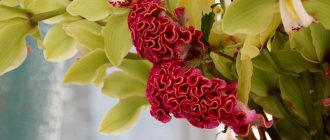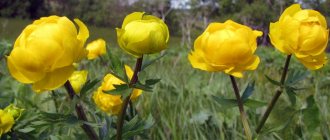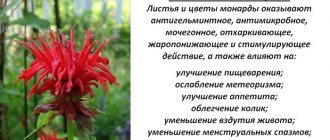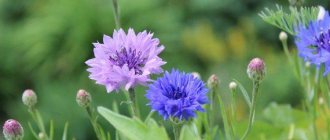Author: Elena N. https://floristics.info/ru/index.php?option=com_contact&view=contact&id=19 Category: Garden plants Published: January 06, 2019Last edits: November 26, 2020
- When to plant
- Growing conditions
- Multi-flowered petunias (multiflora)
There is probably no more popular garden and balcony plant than petunia. The popularity of this flower from the Solanaceae family among professional flower growers and amateur gardeners has not waned for many decades, and in 1921 an asteroid discovered by astronomers was even named after it. Isn't this a confession? Humanity's love for petunia stimulates breeders to create more and more new varieties and hybrids of this delicate, fragrant and charming plant. Some of the varieties that have appeared recently no longer resemble their ancestor, but the growing rules and conditions for keeping petunias of different varieties differ little.
- How to properly grow petunia seedlings?
- When can I transplant it into a flower garden?
- How to care for a plant to maintain its decorative properties at the highest level?
You will get answers to all these and many other questions in our article.
Planting and caring for petunia
- Planting: sowing seedlings at the end of February or in the second half of March, planting in the ground - in the second half of May.
- Flowering: already flowering petunia is planted in the ground. Flowering can last until frost.
- Lighting: bright sunlight.
- Soil: fertile sandy or loamy soil fertilized with compost or humus.
- Watering: at the root during dry seasons.
- Fertilizing: begin to apply fertilizers a week after planting in the ground at intervals of once every 10 days. Stop feeding in August.
- Reproduction: by seed and cuttings.
- Pests: aphids, spider mites, thrips and slugs.
- Diseases: late blight, chlorosis, gray rot, black leg.
Read more about growing petunias below.
Petunia (lat. Petunia) , or Petunia , is a genus of herbaceous perennials and subshrubs of the Solanaceae family, growing naturally in the tropics of Brazil, Argentina, Bolivia, Uruguay and Paraguay. The plant's name comes from the Brazilian word "petun", meaning "tobacco", of which petunia is a relative. One species is even found in North America. There are about twenty-five species of petunias, which sometimes differ greatly from each other. Petunias have been cultivated since the 18th century.
Hybrids obtained by breeders more than a century ago are grown as balcony or garden annuals. Gardeners are attracted by the large bright flowers of petunias, which decorate the garden or terrace with their lush blooms all season long. In addition, petunia combines surprisingly harmoniously with other garden flowers - pelargonium, begonia. Ampelous petunia is very beautiful in hanging arrangements of varieties of different colors. And the main reason for the popularity of this flower is that planting and growing it is not difficult.
- Flower care in August
External links [edit]
- Media related to Petunia × atkinsiana at Wikimedia Commons
| Taxon identifiers | |
| Petunia × Atkinsiana |
|
| Nierembergia atkinsiana |
|
Botanical description
Petunias have a bush-like shape, stems are creeping or erect, densely branched, plant height is from 15 cm to 70 cm, oval whole leaves of petunia are from 5 cm to 12 cm long, arranged alternately, green or dark green in color. Both stems and leaves are pubescent. The flowers are funnel-shaped, solitary, on short peduncles, axillary or terminal, regular or irregular, simple or double, sometimes fringed.
Flower color: reddish, purple, white, pink, violet and blue, with a halo, border, dark veins or a white star.
The fruit is a bivalve capsule with small seeds. In gardens and on balconies, varieties of garden or hybrid petunia are grown, bred from wild species of violet petunia and axillary petunia. Garden petunia blooms from July until frost. Perennial petunia is cultivated exclusively as an annual.
Classification by color
Thanks to the efforts of breeders, petunias have the most incredible colors - for example, even a variety with black petals was bred.
The color of the petals can be monochromatic, but there are options with light or dark stripes in the center.
The following colors are typical for cultivated plants:
- red;
- pink;
- burgundy;
- purple;
- violet;
- blue;
- lilac;
- yellow;
- white;
- orange.
Growing petunia from seeds
Sowing seeds
Beginning gardeners often ask the question of how to grow petunia from seeds. If you have the opportunity to highlight seedlings, then sowing petunia seeds for seedlings can be done in February. But usually the seeds are sown in the second half of March, and it is necessary to sow with a large supply, since due to insufficiently long daylight hours, seed germination is very low.
How to plant snapdragons and how to care for them
The soil for sowing needs to be loose, light and nutritious: two parts of leaf or turf soil, two parts of rotted humus, one part of sand and two parts of peat. The top layer of soil, about 1 cm thick, must be sifted so that the seeds lie evenly on its surface; the prepared soil must be well watered a day before sowing. The seeds are mixed with dry sand and poured onto the ground, leveled, sprayed, covered with glass or film and left to germinate at a temperature of 20-23 ºC. After about a week, seedlings appear, which will require twice daily spraying and ventilation.
The main task during this period is to ensure high air humidity in the greenhouse, but at the same time avoid the risk of sprouts getting blackleg from dampness, so every day, as soon as condensation appears on the glass or film, the glass should be turned over and the film wiped.
In addition, from time to time spray the seedlings not with water, but with a light solution of potassium permanganate. After the first leaf appears on the seedlings, the glass can be removed, the soil can be lightly sprinkled with sand and watering can be reduced.
Growing seedlings
When the seedlings have 3-4 true leaves, they are picked after first moistening the soil in the container. The seedling is carefully lifted with a stick and removed from the soil by the leaf, being careful not to shake off the soil from the roots, and dropped into a peat or plastic pot with the same soil mixture. The picked plants are watered and covered with paper or lutrasil for two to three days.
Caring for petunia requires careful attention at this stage of growth, and the most crucial moment is keeping the soil in a state of constant moderate moisture.
The frequency of watering during this period depends on many factors, so it is up to you to decide whether you will moisten the soil 2-3 times a day or only 1-2 times a week. Don't forget to loosen the soil around the seedlings. They begin to feed the seedlings a week after picking, weekly, alternating foliar and root feeding. To do this, use nitrophoska, Kemira, Mortar and other complex water-soluble fertilizers at the rate of approximately 25-35 g per 10 liters of water.
Gardener's tips for caring for petunia seedlings
Multiflora varieties bloom two and a half months after sowing, grandiflora varieties - after three months. Before planting in open ground, it is advisable to keep the already grown seedlings in a cool room or take them out into the fresh air for some time during the day for acclimatization.
- Nigella: growing from seeds, types and varieties
Links[edit]
- ^ a b
"
Petunia × Atkinsiana
".
Germplasm Resource Information Network (GRIN)
. Agricultural Research Service (ARS), United States Department of Agriculture (USDA). Retrieved April 17, 2014. - "Petunia (band)". Missouri Botanical Garden. Retrieved September 12, 2015.
- Koeduka, T.; Orlova, I.; Baiga, T.J.; Noel, J.P.; Dudareva, N.; Pichersky, E. (2009). “The lack of floral synthesis and isoeugenol release in Petunia axillaris
subsp.
Parodiiis
due to a mutation in isoeugenol synthasegen".
Factory magazine
.
58
(6):961–9. DOI: 10.1111/j.1365-313X.2009.03834.x. PMC 2860387. PMID 19222805. - ^ a b
Brown, Deborah. University of Minnesota Petunia Growing Office Expansion. University of Minnesota. 2009. Internet. June 25, 2009 https://www.extension.umn.edu/distribution/horticulture/DG1120.html Archived October 26, 2013 at the Wayback Machine - ^ a b c
Engebreston, Don., Williamson, Don.
Annuals of Minnesota and Wisconsin
. Lone Pine Publishing. 2004. Print. - Russ, Karen. "Petunia". Clemson expansion. Clemson University. September 2007 Internet. July 1, 2009 < https://www.clemson.edu/extension/hgic/plants/landscape/flowers/hgic1171.html >
- Petunia atkinsiana
'Storm Lavender'. RHS. Retrieved January 18, 2022. - Petunia atkinsiana
'Storm Pink'. RHS. Retrieved January 18, 2022. - Petunia atkinsiana
'Storm Salmon'. RHS. Retrieved January 18, 2022. - [1]
Planting petunia
When to plant
Petunia prefers to grow on sandy or loamy fertile soils, responding with gratitude to the addition of compost or humus to the soil before planting seedlings, but not manure, which contributes to the development of fungal diseases. The site should be open and sunny. Petunia seedlings are planted when all the spring frosts are behind us (approximately in the second half of May), and it is advisable to choose a cloudy day or evening for this.
In the photo: White petunias blooming
How to plant
If you plant already flowering petunia, it will bloom until November. Usually, due to its short growth, petunia is planted along the edge of the flower bed. The seedlings in pots are first watered well, then planted together with a lump of earth, keeping a distance of 30-40 cm between the bushes. After planting, the petunia is watered, and the next day the area is mulched.
Petunia care
Growing conditions
Growing petunias will not require any extra effort from you, but to achieve the best results, you need to start by mastering the theoretical information about how to care for petunias. Despite the fact that adult petunia is a drought-resistant plant, in hot summers it requires watering, and large-flowered varieties are more demanding in this matter than small-flowered ones.
Growing chrysanthemums from seeds - everything you need to know
Watering is carried out at the root so as not to damage the most delicate petunia flowers. The day after watering, the area with petunia is weeded to remove weeds and loosened so that a crust does not form on the ground. But the most important thing on which the beauty and duration of flowering of petunias depends is regular feeding.
You need to start feeding petunia a week after planting the seedlings in the ground and continue feeding with complex fertilizer with a predominance of potassium every ten days until August. Sometimes you can use organic matter as a top dressing, for example, mullein infusion or humic fertilizers.
In the photo: Petunia blooming
Propagation by cuttings
This method is used to propagate mainly ampelous and double petunias, as well as all calibrachoa cultivar groups (mini-petunias). Cuttings of terry petunia are carried out at the end of winter or early spring, and calibrachoa and ampelous petunias, provided they are illuminated with fluorescent lamps and the air temperature in the room is 21-24 ºC, can be cut at any time of the year. From the mother petunia, apical cuttings with 4-6 leaves are taken, but only the top two leaves are left on the cuttings, and even those are shortened by half, the cuttings are planted in the same mixture as petunia seeds, but sand or perlite is poured on top in a layer of 2-2, 5 cm, spilled with fungicide solution. Place the cuttings at a distance of 1.5-2 cm from each other, and cover the container with glass.
There is no need to use a growth stimulator (for example, heteroauxin), the main thing is that the cuttings are freshly cut, because their ability to root decreases every minute.
Make sure that the soil in the greenhouse is constantly moist, spray the cuttings with a sprayer twice a day, but do not add dampness to the container: mold or blackleg may appear. After about a week, ampelous and terry petunia takes root, calibrachoa - after two weeks. When the roots of the seedlings become 1-1.5 cm long, they are planted in pots with a diameter of 5 cm. The seedlings are pinched to enhance bushiness above 4-5 leaves, and the tops of the shoots cut off when pinching are excellent cuttings for rooting. If necessary, pinch the petunia shoots again after two weeks.
After a month and a half, the plants are planted in pots with a diameter of 11-13 cm. Caring for petunia cuttings is approximately the same as for seedlings, but calibrachoa and hanging petunias require more space, so the pots with them are usually hung.
In the photo: Beautiful large petunia
Pests and diseases
I will repeat once again: if you comply with the requirements of agricultural technology, then neither diseases nor pests will harm your plants. But we do not live in an ideal world, which is why from time to time we hear complaints that petunia dries out or petunia turns yellow. If the rules for caring for petunia are not followed, it can develop late blight, chlorosis, blackleg, gray rot, which can be combated with special preparations and, what is more important and easiest, prevent these troubles by following the rules for caring for the plant. If the rules are not followed, then in addition to fungal diseases, petunia can be affected by viral diseases, and no cure has yet been invented for them.
Among the pests that can pose a danger are spider mites, aphids, slugs and thrips; means of combating them have been described repeatedly.
How to collect seeds
If you decide to collect petunia seeds, wait until they ripen on the bush. At the very beginning of flowering, mark out several lower buds on the petunia bushes of the varieties you want to sow next year, since in them the process of formation and ripening of seeds is faster. From the moment the buds form until the seeds fully ripen, about two months pass.
In the photo: Blooming variegated petunias
Petunia seeds are very small, their diameter is approximately 0.5 mm, there are about a hundred of them in a box. You can cut the seed pods and store them at home, but it is better to shake the seeds out of the pods, put them in bags and write on each of them the name of the variety and the year the seeds were collected. The seeds are ripened at room temperature for three to four months. When properly stored, petunia seeds do not lose their viability for up to four years.
- Doronicum: growing in open ground, types
Some tips
- To make petunia seedlings or rooted cuttings easier to transplant into open ground, it is better to do this in cloudy weather or in the evening.
- To better retain moisture and protect against minor ground frosts, thoroughly mulch the plants with peat.
- When planting hanging plants in pots, pay attention to the height of the sides; they should be no higher than 5 cm. Otherwise, even with slight swaying, the branches rub against the edge and break.
- It is not necessary to make additional drainage in flower pots; special holes in the bottom are enough. Since the soil of petunias dries out very quickly.
- Carry out watering and fertilizing procedures in the evening, because with active sun they can cause burns on petunia leaves.
As you can see, growing petunias is not particularly difficult. But it is very beautiful and versatile to use.
Petunia will make any flower bed or flower garden beautiful. Ampelous ones look chic in hanging flowerpots and tall flowerpots. They can also be used as ground cover (this is especially beautiful in stone gardens). And in combination with lobularia, coleus, begonia and cineraria they can form a picturesque carpet.
Any entrance will be solemn and elegant if flowerpots with flowering petunia caps are placed near it.
Petunias coexist harmoniously with many plants. They are good both in a flowerbed and in flowerpots in combination with alyssum, verbena, gazania, pelargonium, bacopa and others. But as soloists they are simply magnificent!
Petunia after flowering
If you really want to keep a particularly attractive faded petunia at home, dig it up in October, trim the stems, plant it in a pot and place it in a cool room where it will rest while you keep the soil moderately moist with occasional watering. In February, move the “sleeping beauty” to a bright and warm windowsill and resume regular watering. When the young shoots have 2-3 pairs of leaves, they are cut off with a “heel”, planted in a flowerpot with fertile soil, on which a layer of sand is poured, the flowerpot is covered with film or glass, placed in light shade and cared for by watering, ventilating and spraying as necessary for three weeks until the shoots grow roots. Then the seedlings are planted in cups and grown until it is time to plant them in the ground.
In the photo: Petunias in a flowerbed
If you don’t want this hassle and plan to buy and sow new seeds in the spring, treat petunia as you would an annual plant: remove the remaining bushes from the area and dig up the area.
Characteristic
Useful and harmful properties
In addition to lush, beautiful flowering, Petunia also has beneficial properties. It has long been known that after walking or sitting next to this beauty, a person’s mood rises and his well-being improves. No harmful properties have been identified in the plant.
Beneficial features:
- Stimulates the functioning of the circulatory, cardiovascular, central nervous and digestive systems.
- Relieves headaches.
- Petunia's scent repels mosquitoes.
We invite you to watch a video about the beneficial properties of petunia:
Allergy
Petunia is one of the balcony and indoor plants that do not cause allergies ; it can be safely grown both in garden plots and at home.
Types and varieties of petunias
Varieties of hybrid petunias are divided into two groups - multi-flowered petunias and large-flowered petunias.
Multi-flowered petunias (multiflora)
They bloom earlier than large-flowered ones, forming on their bushes a large number of flowers with a diameter of up to 5 cm, which bloom for a very long time. They are not capricious, grow in any soil, are not afraid of rain and love the sun - real garden flowers. Maybe they are not as chic as large-flowered ones, but compact bushes, completely covered with flowers of various shades, delight the gardener's eye until the very autumn cold. Popular varieties of petunia multiflorum:
In the photo: Garden petunia
- Fantasy - a series of nine hybrids, plant diameter and height 20 cm, flowers 4 cm across, colors: pink-raspberry, red with veins and white throat, violet-blue, salmon, white, red-raspberry, soft pink with cream throat, delicate salmon with dark veins, etc.;
- Mirage is a series of 13 compact hybrids, double flowers 6-9 cm in diameter in the following colors: pink-lilac with purple veins, pink with dark pink veins, pink with red-crimson veins, red with burgundy veins, white, burgundy-crimson and etc.;
- Plumcrystals - bush height is about 30 cm, diameter - 25 cm, flowers up to 7 cm. The color of the flower gradually becomes lighter over time: first pink-lilac, then light lilac, then barely lilac. The contrast to the main color is made up of violet-burgundy veins.
In the photo: Multi-flowered petunias (multiflora)
Large-flowered petunia (grandiflora)
The most common group of hybrids, numbering hundreds of varieties. It is distinguished, as is already clear from the name, by large beautiful flowers, which, however, are not as numerous as those of the small-flowered one. A significant disadvantage of this group is that its flowers are easily damaged by rain and wind, causing it to lose its decorative effect, so most often this petunia is grown in pots or containers indoors, on balconies and terraces. This group is divided into several subgroups:
- large-flowered (bush height up to 60 cm, smooth flowers 8-10 cm in diameter),
- large-flowered low (25-30 cm tall, other characteristics are the same as those of large-flowered),
- large-flowered fringed and large-flowered fringed low (bush height 65-70 cm and 25-30 cm, respectively, fringed flowers up to 12 cm in diameter),
- large-flowered superior and large-flowered superior low (bush height 50-75 cm and 30-40 cm, respectively, smooth flowers with a wide throat 10-12 cm in diameter are covered with darker veins than the background),
- large-flowered double (bush 50-60 cm high with large double flowers 10-12 cm with smooth or fringed edges). The most popular series of petunia grandiflora:
- The hit parade are fast-blooming hybrids up to 25 cm high with a wide range of colors: pink, crimson, white, with a white star on a blue background, salmon, blue-violet, etc.;
- Pikoti is a series consisting of four hybrids, the distinctive feature of which is the edge of the petals, which are heavily corrugated and surrounded by a white one and a half centimeter border. The height of the bush is 25 cm, the color of the flowers is red, purple, pink, blue-violet, crimson;
- Purple pirouette is a violet-purple terry hybrid with a white border along the fringed edge of corrugated petals, bush height 25 cm.
In the photo: Large-flowered petunia (grandiflora)
Petunia floribunda
In addition to these two most popular groups of petunias, there is also petunia floribunda, which occupies an intermediate position between the first two. The flowers of this group are almost not damaged by rain, like the flowers of small-flowered petunia, but plants of this group look impressive only in bulk, so they are grown mainly in large flower beds. Varieties:
- Sonia is the most popular variety series of 11 hybrids. Bush height - 25 cm, flower color: pink, raspberry, raspberry-pink with a white star, raspberry-burgundy with a white star, red with a white border, white, red, light purple with purple veins, etc.;
- Celebrity is a series of heat-resistant and rain-resistant hybrids presented in thirteen colors, both single-color and two- or three-color.
Garden group of petunias
balcony, or ampelous, differs from all other types in the length and flexibility of the stems, which tend to grow downward. Petunias of this group grow quickly and are resistant to bad weather. Varieties of ampelous petunia:
- Surfinia - flower diameter from 6 cm to 9 cm, with the exception of miniature varieties Pink Mini, Mini Purple, which have flowers 5.5 cm in diameter. Of all the possible shades, among the surfinias there is no petunia only orange and bright yellow;
- Tumbelina is a product of the Japanese company Suntory, a variety series with double flowers;
- Conchita is a series of hybrids that are more reminiscent in shape and size of a calibrachoa flower (mini-petunia). Small flowers 5 cm in diameter of various colors and colors.
Multifloral
An unpretentious petunia, planting and caring for it is simple and uncomplicated. These flowers will be happy in any land, provided that the place chosen for them is warm and sunny. Numerous flowers are small, only 5 cm in diameter, but they bloom profusely and for a long time, and are resistant to cold weather and rainy weather. These types are ideal for carpet flower beds, designing large flower beds, borders and ridges (long, elongated flower beds).
Bright and beautiful multi-flowered petunia
Multi-flowered deep blue petunia











